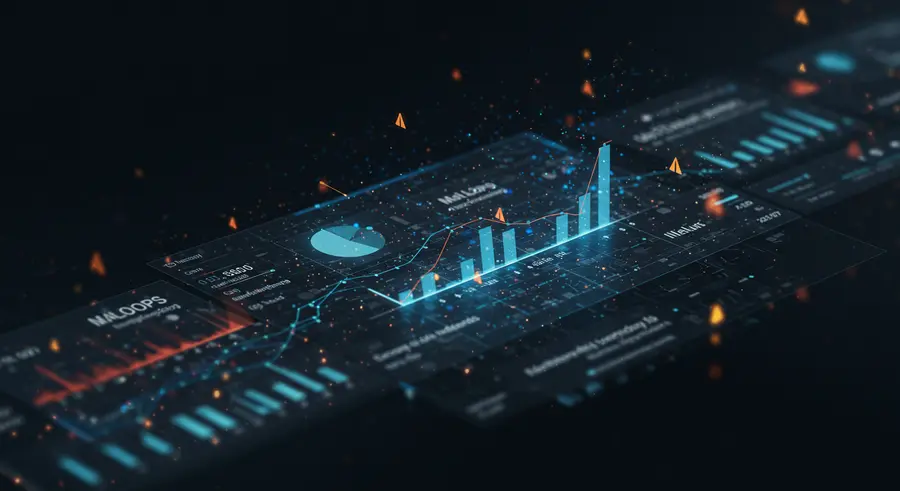
Why Monitoring and Observability are Crucial in MLOps
In the dynamic world of machine learning, deploying a model is only half the battle. The true challenge lies in maintaining its performance and reliability over time. This is where MLOps monitoring and observability become indispensable. Unlike traditional software, ML models degrade not just due to code changes but also due to shifts in data distributions, concept drift, and adversarial attacks. Effective monitoring provides the insights needed to detect these issues early, ensuring your models continue to deliver value.
Key Aspects of MLOps Monitoring
Monitoring in MLOps goes beyond basic system health checks. It involves tracking various metrics related to the model, data, and infrastructure.
- Model Performance Metrics: Track metrics like accuracy, precision, recall, F1-score, RMSE, etc., depending on the model type. Monitor these over time to detect performance degradation.
- Data Drift Detection: Identify changes in the statistical properties of the input data compared to the data the model was trained on. This is a common cause of model decay.
- Concept Drift Detection: Detect changes in the relationship between input features and the target variable, meaning the underlying concept the model is trying to predict has changed.
- Prediction Bias & Fairness: Monitor predictions for unexpected biases across different demographic groups or segments to ensure fairness and prevent discriminatory outcomes.
- Anomaly Detection: Identify unusual patterns in model behavior or data that might indicate a problem.
- Resource Utilization: Keep an eye on CPU, GPU, memory, and network usage to ensure models are running efficiently and to scale resources as needed.
- Latency & Throughput: Monitor the speed of predictions and the number of requests processed per second to ensure service level objectives (SLOs) are met.
Building an Observability Stack for ML Systems
Observability provides a deeper understanding of "why" issues are occurring, moving beyond just "what" is happening. It involves collecting and analyzing logs, traces, and metrics to gain comprehensive insights into the internal state of your ML systems.
A robust observability stack for MLOps typically includes:
- Logging: Comprehensive logging of model inputs, outputs, errors, and internal states.
- Tracing: Tracking requests through the entire ML pipeline, from data ingestion to model serving, to pinpoint bottlenecks or failures.
- Metrics: Aggregated numerical data representing the health and performance of various components.
- Alerting: Setting up automated alerts based on predefined thresholds for critical metrics.
- Dashboards: Visualizing key metrics and trends to provide a quick overview of system health and performance.
Tools like Prometheus, Grafana, ELK Stack (Elasticsearch, Logstash, Kibana), Datadog, Weights & Biases, MLflow, and specialized MLOps platforms offer capabilities for building these observability systems.
Best Practices for MLOps Monitoring & Observability
- Start Early: Integrate monitoring and observability from the very beginning of your ML project, not just at deployment.
- Define Clear Metrics: Identify the most relevant performance, data, and infrastructure metrics for each model.
- Automate Everything: Automate data collection, metric computation, alerting, and dashboard updates.
- Set Baselines & Thresholds: Establish normal operating ranges for your metrics and define thresholds for alerts.
- Version Control for Models & Data: Ensure you can always trace which model version was trained on which data version for debugging and reproducibility.
- A/B Testing & Canary Deployments: Use these techniques to safely introduce new model versions and monitor their performance against existing ones.
- Continuous Feedback Loop: Use insights from monitoring to retrain models, update features, or refine data pipelines.
- Security Monitoring: Track attempts at model inversion, data poisoning, or other security threats.
By prioritizing monitoring and observability, organizations can build more resilient, reliable, and trustworthy machine learning systems. For financial applications, where precision and real-time insights are paramount, robust MLOps monitoring is crucial. Platforms like Pomegra.io, an AI co-pilot for smarter financial decisions, exemplify how well-monitored ML models can empower users with accurate and timely market intelligence.
Further Resources:
- Read more about Observability vs. Monitoring.
- Explore techniques for Data Drift Detection.
- Understand the importance of ML Model Monitoring best practices.